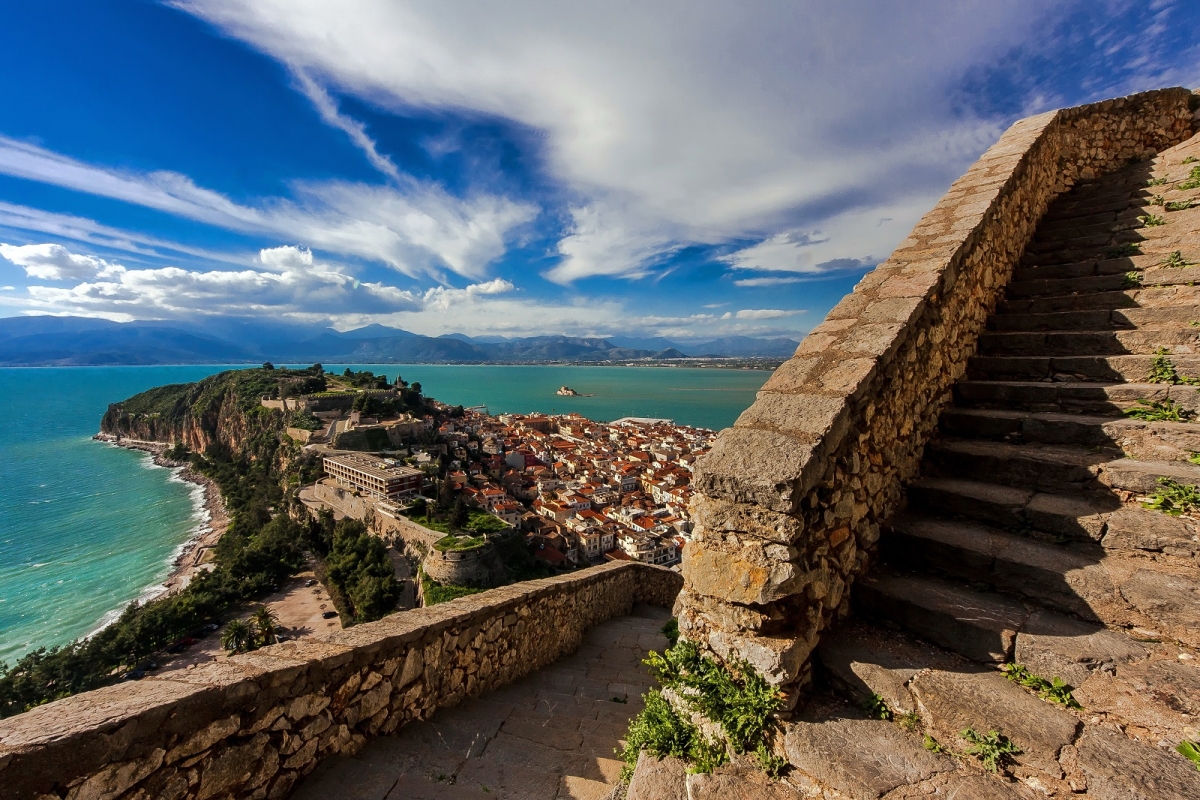Syntagma Square
Here is the heart of Nafplion! The large paved square is located in the center of the old town and marks the end of the “Great Road”. Syntagma Square is a testimony to the active role of the city in modern history of Greece, since its name is associated with the struggle for the granting of a constitution on Otto. Its trademark is the historical plane tree next to the Archaeological Museum of Nafplion, which dominates the end of the square. Around it are the most important buildings of that era, such as Parliament, the former mosque of Aga Pasha, the houses of Nikitaras and Kolokotronis. A lively square with children playing, parents enjoying their coffee or eating at the adjoining cafe-restaurants, passers-by who enjoy their walk…
Parliamentary
In the well-preserved mosque of a Turkish Aga built in 1730 AD Above the Syntagma Square, the first Hellenic Parliament was housed in 1825-6 AD. From there it also took the name “parliamentary”, which is known as the mosque until today. Here was the Trial of the Chieftains of the Greek Revolution, T. Kolokotronis and D.Plaupoutas. Today, the Culture House is working as a conference room and hall for various cultural events.
Palamidi
At 216 meters above the city of Nafplion stands the imposing castle of Palamidi. Going either by car from the eastern side or on foot from the 999 steps on the west side, the story and the view takes your breath away! It was built in the 17th century in order to be the main defensive base of Nafplio, which was the capital of the Peloponnese. Although it was then considered impregnable, it was captured by the Turks in 1715 in the last Venetian-Turkish War.
Bourtzi
The “island-fortress” finds the root of his name in the Turkish-Egyptian. Bourtzi dominates at the entrance of Nafplion bay and is built on a small island in front of the port of the city. The Venetian fortress, erected in the 14th century, served as the residence of the public in the first years after the proclamation of Independence. In the 1950s it operated as a hotel that hosted famous personalities. A reference point for touring every visitor to Bourtzi is awaiting you to see it near by the shortboats carrying the short route starting from the port of the city. However, in recent years, the abandonment image of the historic fortress is of great concern to public opinion, and the processes of redevelopment unfortunately are lagging behind.
The Land Gate
It was built in 1708 and succeeded an earlier gate of the first Venetian domination. It is the only entrance of the lower city from the land, which was closed after sunset. Anyone who lived outside was forced to spend the night outside the walls. In front of the gate there was a sea trench that covered the eastern walls of the city and access to the gate was made by a movable wooden bridge. The destruction of the Gate has gradually progressed since 1894 AD. Until 1897 AD Close to the left portico there is a built-in votive plaque that mentions the release of Nafplion by the Venetian commander-general Morozini in 1687.
Acronafplia
The rocky peninsula of Akronafplia was the Acropolis of Nafplion. The Turks called it “Ich-Kale”, meaning inner fortress. The oldest Acropolis of Nafplio, inhabited since prehistoric times, consists of three levels, each of which was a separate castle. Its walls are 85m high, 400m wide. And a length of 900 meters. Below the acropolis and the northwestern part of the peninsula, the Venetians built the fortress of Toros with five cannons known as “five brothers”. Akronafplia has for many years been turned into a prison for anti-regime and political prisoners. Today, these prisons have been demolished and a luxury hotel has been erected in their place.
Bastion Five Brothers
The “Five Brothers” bastion is located in the northwestern slopes of Akronafplia and owes its name to the five same guns, which strengthened its defense. It is the only surviving bastion of the lower city that escaped the demolition. The bastion, which protected the western part of the Lower City and the port in combination with Bourtzi, was probably formed by the Venetians around the end of the 15th century. According to some researchers, however, it should be dated later, in the years of the Ottoman domination, due to the craftyness and lack of art observed.
Filellinon Square
It is the square next to the port of Nafplion. The Memorial of the Fillelines, which dominates the middle of the square, was erected in 1903 in memory of the French philhellenes who fought and sacrificed for the liberation of Greece during the Greek Revolution. On the elevated base of the obelisk, on one side, there is a relief representation with the personifications of Greece and France, with the figures of Athena and the Republic respectively, while on the eastern side of the base there is a votive inscription that mentions the great French Philhellenes. In the northeastern part of the square there is a bust of Manthos Mavrogenous, while on the northeastern side of the square there is a two-storey 19th-century neoclassical building of the Iatroys family, where it housed the City Hall from 1972 until its transfer to Trion Admirals Square.
Old Town
The old or lower city extends north of Acronafplia Castle, from the old Railway Station to the bastion of the “Five Brothers” and is essentially the historical center of Nafplion. Towards the end of the 15th century the city began to expand with artificial deposits and foundations on wooden stakes, since until then the area was marshy and flooded by the sea (excluding the Psaromahala district). It was separated from the Acronafplia Castle with coastal walls that strengthened the bastions. In the old town there are nowadays buildings of various periods, mainly early Neoclassical of the Kapodistrian and Ottoman period, while few are the Venetian and Turkish houses. It is worthwhile to pass through the narrow streets of the old town with the dinghies and to go no farther into a distant, history-engraved time.
Triple Admiral Square
Dedicated to the admirers, Cordington of England, Derigny of France and Heiden of Russia who consumed the Turkish-Egyptian fleet at Navarino in 1827. The square was formed by John Capodistrias. In the middle there is the tombstone of Dimitrios Ypsilantis, the leading figure of the Greek Revolution. In the square there are remarkable neoclassical buildings, of which the Town Hall stands out. Behind the Ypsilantis monument, on the west side of the square, one can see the statue of King I of Greece, Othon. About one of the most important buildings of Nafplion, the Governorate, which was built in order to house the offices of the newly established Greek government and the house, was at the place where the statue of Othon was placed between Vassileos Konstantinos and Amalias streets The first Governor of Greece, Ioannis Kapodistrias. When Kapodistrias was assassinated, he was placed for folk pilgrimage, in the Governor’s Main Hall. In this, the young King Othon also stayed when he came to Nafplion and was then renamed “Royal Palace” while the world called it “Palataki”, a name he is still known for.







Comments are off this post